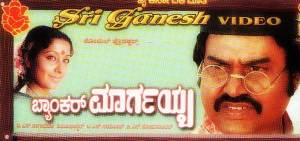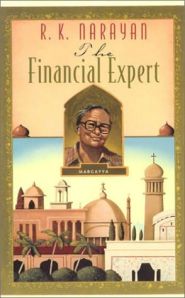Someone once asked, “If you can say something as an essay, book or even a letter to the editor, why would you want to make a film out of it?” I have hardly bought another idea more wholeheartedly. From extending that thought, unless out of a commercial interest, why would you want to make a film of something whose content has already made it to a book? Going further, even if you adapted from a book, should you not be aiming a lot higher than the book’s content itself?
T.S. Nagabharana’s Banker Margayya is one film which faces this issue of adaptation (called adoption in the title sequence). However, it would be stupid to “blame” the film. Made some 25 years ago it doesn’t need to answer someone who found a DVD only now. Instead, there were certain elements in the film which convinced me that adaptations are affairs fraught with dangers. Danger to the original source and danger to the new product as well.
The film is derived from R.K. Narayan’s Financial Expert, another of his works set in Malgudi. Margayya is a smart money-lender who, by advising villagers about the rules of borrowing money, sends corrupt bank officials running scared. By a quirk of fate he loses this upper hand. He tries odd jobs to beat poverty but it takes another quirk of fate for his life to change. As with a lot of Narayan’s works, the sum total of joy and despair might end up at zero, but the experience is always up in the positives.
There are two “quirks of fates” I have mentioned above, and after those, there are lots of ups and downs in the life of the protagonist. And if you want to make a film of this, you have to control the crests and troughs so rigorously that they fit inside 150 mins. That is essentially a problem with adaptations: a question of how much you can remove.
The first third of Banker Margayya is an absolute joy. This is until Dr. Pal (played by Sundarkrishna Urs) enters the scene. What you notice till this point is the remarkable control of Nagabharana over the subject. It is right down his alley: the daily bickering of the husband and wife, the impish pranks of the child, the bitching neighbours and the Malgudiness of the village. Add to this Lokesh’s performance. It really is a lot of fun.
Once Dr. Pal enters the scene, there are only crests and troughs and they come in quick succession. The script decided to stay true to these and it doesn’t have much time to cover everything and it becomes just ticking of boxes from here on. Every chapter has to be given its due and every turn in the story has to be respected. What results is a clumsy film, unbalanced by the burden of its source.
Suppose the adaptation had stopped at a convenient stage (like here, roughly at the first third), and the film had followed its own course, would it have made a better film? If the catalyst in this story, the character of Dr. Pal, had been struck off, would it have led Margayya to hatch other, more fruitful (for the film) plans? I am convinced the problem wasn’t anything other than the many turns of the original book. It takes few pages to explain that in a book, or even just a few ingenious words. In a film, it takes reels of celluloid and hours of camera hire to squeeze and distort a story into the limit posed by time.
As defended earlier, this isn’t to “blame” Banker Margayya or its adaptation per se. It led me to believe that much of films made in the name of spreading messages and adapting books, at least in today’s era, are almost always fruitless. Unless the idea is to make money.
A word on Nagabharana’s other adaptation to end this. He made Nagamandala, Girish Karnad’s play, into a very effective film. While Banker Margayya is a good film, it could have been more than an adaptation of Financial Expert. It might thus seem that some sources lend themselves to easy adaptations while some need to be cut, pasted, ignored or destroyed to make a bigger work of film.
Banker Margayya – Story of Adaptation
11 Sunday Oct 2009

Anna Karenina was made into films many times(35,49,97) that I know of but its impossible to do even a semblance of justice to the 1000 page novel with all its depth. On the other hand Kurusawa adopted two Shakespeare dramas into Japanese which are admirable on their own two feet. Maqbool and Onkara are two examples where ready made plots have been adopted. I haven’t read Saratchandra but Bimal Roy’s Devdas was a masterpiece of melancholy requiring no other credential.
With Kurosawa and Vishal Bharadwaj, the adaptated films have been more their own narrative. It is when you have to take a book completely into a script that problem might arise
Pingback: UPC – 4: Critics « Off the mark
I liked the movie banker margays a lot.i thought that it captured the essence of r k Narayan .no other adaptation other than Shankar nags malgudi days have captured the essence of r k n.
But your analysis is very well written.wish I could write or adapt like you
Dr satish rao
thank you